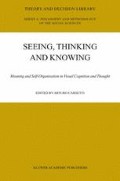Access this chapter
Tax calculation will be finalised at checkout
Purchases are for personal use only
Preview
Unable to display preview. Download preview PDF.
References
Arno, P., Capelle, C., Wanet-Defalque, M.-C., Catalan-Ahumada, M., & Veraart, C. (1999). “Auditory coding of visual patterns for the blind.” Perception, 28, 8, pp. 1013–1029.
Bach-y-Rita, P. (1967). “Sensory plasticity. Applications to a vision substitution system”, Acta Neurologica Scandinavica, 43, 4, pp. 417–426.
Block, N. (1995). “On a confusion about a function of consciousness”, Behavioral and Brain Sciences, 18, 2, pp. 227–247.
Botvinick, M., & Cohen, J. (1998). “Rubber hands ‘feel’ touch that eyes see [letter]”, Nature, 391, 6669, pp. 756.
Broackes, J. (1992). “The autonomy of colour”. In K. Lennon & D. Charles (Eds.), Reduction, Explanation, and Realism, Oxford University Press, pp. 421–465.
Chalmers, D. J. (1996). The conscious mind: In search of a fundamental theory, Oxford University Press.
Clank, A. (2000). “Phenomenal immediacy and the doors of sensation”, Journal of Consciousness Studies, 7, 4, pp. 21–24.
Dennett, D. C. (1991). Consciousness Explained, Little Brown.
Grush, R. (1998). “Skill and spatial content”, The Electronic Journal of Analytic Philosophy (Vol. 6), http://www.phil.indiana.edu/ejap.
Hurley, S. L. (1998). Consciousness in Action, Harvard.
Hurley, S. L., & Noë, A. (2003). “Neural plasticity and consciousness”. Biology and Philosophy, 18, I, in press.
Iriki, A., Tanaka, M., & Iwamura, Y. (1996). “Coding of modified body schema during tool use by macaque postcentral neurones”, Neuroreport, 7, 14, pp. 2325–2330.
Järvilheto, T. (2001). “Feeling as knowing — Part 2. Emotion, consciousness, and brain activity.” Consciousness & Emotion, 2, 75–102.
Levine, J. (1983). “Materialism and qualia: The explanatory gap.” Pacific Philosophical Quarterly, 64, pp. 354–361.
Meijer, P. B. L. (1992). “An experimental system for auditory image representations”, IEEE Transactions on Biomedical Engineering, 39, 2, pp. 112–121.
Myin, E. (2001), “Color and the duplication assumption”, Synthese, 129: 1. pp. 61–77.
Myin, E., & O’regan, J. K. (2002). “Perceptual consciousness, access to modality and skill theories: A way to naturalize phenomenology?”, Journal of Consciousness Studies, 9, 1, pp. 27–45.
Nagel, T. (1974). “What is it like to be a bat?”, Philosophical Review, 83, pp. 435–456.
Noë, A. (2002). “On what we see”, Pacific Philosophical Quarterly, 83:1
Noë, A. & O’regan, J.K. (2000). “Perception, attention and the grand illusion”, Psyche, 6 (15). URL: http://psyche.cs.monash.edu.au/v6/psyche-6-15-noe.html
Noë, A. & O’regan, J.K. (2002). “On the brain-basis of visual consciousness”. In A. Noë & E. Thompson: Vision and Mind: Selected Readings in the Philosophy of Perception. MIT Press.
O’regan, J. K. (1992), “Solving the ‘real ‘mysteries of visual perception: the world as an outside memory” Canadian Journal of Psychology, 46, pp. 461–488.
O’regan, J. K., Rensink, R. A., & Clark, J. J. (1999). “Change-blindness as a result of ‘mudsplashes’.”, Nature, 398, p. 34.
O’regan, J. K., & Noë, A. (2001a). “Acting out our sensory experience” Behavioral and Brain Sciences, 2, 5, pp. 955–975.
O’regan, J. K., & Noë, A. (2001b). “A sensorimotor account of vision and visual consciousness”, Behavioral and Brain Sciences, 24, 5, pp. 883–917.
O’regan, J. K., & Noë, A. (2001c). “What it is like to see: A sensorimotor theory of perceptual experience”, Synthese, 129, 1, pp. 79–103.
Pessoa, L., Thompson, E, & Noë, A. (1998). “Finding Out About Filling In: A Guide to Perceptual Completion for Visual Science and the Philosophy of Perception”, Behavioral and Brain Sciences, 21: 6, pp. 723–748.
Pettit, P. (2003a). “Looks red”, Philosophical Issues, 13, in press.
Pettit, P. (2003b). “Motion blindness and the knowledge argument.”. In P. Ludlow, Y. Nagasawa, & D. Stoljar (Eds.), The Knowledge Argument, MIT Press.
Rensink, R. A., O’regan, J. K., & Clark, J. J. (2000). ‘On the failure to detect changes in scenes across brief interruptions. Visual Cognition, 7, 1–3, pp. 127–145.
Richardson, B. L., & Frost, B. J. (1977). “Sensory substitution and the design of an artificial ear” J Psychol, 96, 2d Half, pp. 259–285.
Roe, A. W., Pallas, S. L., Hahm, J. O., & Sur, M. (1990). “A map of visual space induced in primary auditory cortex” Science, 250, 4982, pp. 818–820.
Sampaio, E., Maris, S., & Bach-y-Rita, P. (2001). “Brain plasticity: ‘visual’ acuity of blind persons via the tongue”, Brain Research, 908, 2, pp. 204–207.
Simons, D. (2000). Current approaches to change blindness. Visual Cognition, 7, pp. 1–16.
Veraart, C., Cremieux, J., & Wanet-Defalque, M. C. (1992). “Use of an ultrasonic echolocation prosthesis by early visually deprived cats” Behavioral Neuroscience, 106, 1, pp. 203–216.
Yamamoto, S., & Kitazawa, S. (2001). “Sensation at the tips of invisible tools”, Nature Neuroscience, 4, 10, pp. 979–980.
Author information
Authors and Affiliations
Editor information
Editors and Affiliations
Rights and permissions
Copyright information
© 2004 Kluwer Academic Publishers
About this chapter
Cite this chapter
O’Regan, J.K., Myin, E., Noë, A. (2004). Towards an Analytic Phenomenology: The Concepts of “Bodiliness” and “Grabbiness”. In: Carsetti, A. (eds) Seeing, Thinking and Knowing. Theory and Decision Library A:, vol 38. Springer, Dordrecht. https://doi.org/10.1007/1-4020-2081-3_5
Download citation
DOI: https://doi.org/10.1007/1-4020-2081-3_5
Publisher Name: Springer, Dordrecht
Print ISBN: 978-1-4020-2080-3
Online ISBN: 978-1-4020-2081-0
eBook Packages: Springer Book Archive

